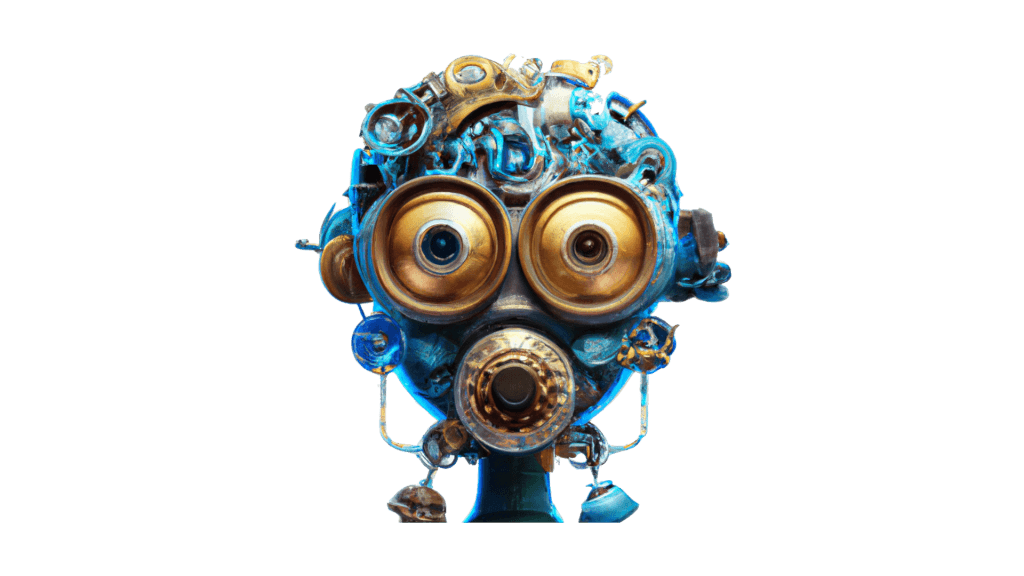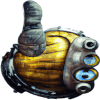Nearly all biohackers agree on one thing concerning the infamous Twaddle virus: it was elegantly scripted. Contagious via mere touch or aerosol dispersal (a sneeze, a cough), the synthetic infection was able to cross the blood-brain barrier within hours of contact with a human host. A retrovirus, it wrote itself ineradicably into the victim’s cortical genome, forever altering the sufferer’s neurochemistry. As a final insult, the parasite caused the mocking signature logo of its unknown maker to appear upon the brow of each victim, scribed in colorful active OLED nanopixels: a GIF of an obese cartoon duck waddling across a barnyard: what soon came to be known as “the Twaddle duck.”
Of course, the well-known primary effect of hosting the virus was something else entirely, and rather more severe and debilitating.
The Twaddle virus caused in each host a continuous logorrhea, a stream-of-consciousness dump, uncontrollable and omnidirectional. The victims resembled Tourette’s sufferers, and experts speculated that the Twaddle designer had learned how to tweak that same neural circuitry. But an additional wrinkle obtained: the insidious hacker had built an automatic shuffle function into the bug. The victim’s oral spew jumped in unpredictable scattershot fashion among any and all topics available to his or her mind, at such a rate that the Twaddler’s pronouncements–“blurts”–were all clipped and relatively short.
The Patient Zero of the Twaddle plague is generally deemed to be one Durst Jacksy, a young Berlin-based musician with a small following in the underground “grey goo” scene. Some have speculated that Jacksy was Twaddle’s actual designer. Others, that he merely represented an unfortunate first host to the accidentally escaped, or deliberately released, virus. In either case, data-mining research across the entire internet has definitively pegged Jacksy as the original locus of the disease.
The patrons of the Kurférstendamm café known as Durchfall’s were alarmed to see a wild-eyed, panting Jacksy burst into the establishment one autumn morning, spouting a stream of unprovoked non-sequiturs. One patron recorded the historic incident with her smartphone, and a rough transcription (into English) of Jacksy’s historic first blurts is attached here:
“What a sunrise! Can’t wait for Harry Potter Meets the Incredibles. Have you seen the price of guitar strings lately? Where’s my car keys, I’ve got an appointment. Elections don’t change a damn thing. Mom always loved Uther best. I need new shoes. That sex with Adette was fantastic! Ginger cookies and milk remind me of school days. These pants are my favorite ones. Cancer took my uncle first, then his wife. I wish Lady Gaga hadn’t married the American president. Kittens are cute until about a month old. Have yourself a merry little Christmas!”
The video continues to show all of Jacksy’s concerned friends clustering around him, trying to calm and help him. (Of course, they were immediately infected, thereby launching the plague across the city, and thence the world.) “Is he on drugs?” someone asks. A despairing Jacksy covers his mouth with both hands, muffling his speech but not stopping it. The spectators recoil in horror when the Twaddle duck emerges on his forehead. Eventually, an ambulance crew arrives and takes Jacksy away. But much, much too late to halt the plague.
The subsequent few weeks followed the standard pattern of all twenty-first-century epidemics: confusion, panic, official reassurances, recognition of the vector, quarantine, analysis of the infectious agent, and ultimately and to much global relief, the creation of a reliable vaccine. But all those developments took nine months, and by then nearly one hundred million people worldwide had been infected. What was worse, they were incurable. The vaccine only protected against initial infections.
The accommodation by society to one hundred million thought-broadcasting beacons in its midst was disparate, to say the least, varying from one country to the next, from one city to the next, and even from one neighborhood to the next.
In some places, the Twaddlers were shunned and ostracized, even subject to disgusting acts of violence. In other places they actually acquired “followers,” cultish or stylishly ironic acolytes who trailed the victims, treating every blurt as a kind of Delphic utterance, annotating them, trading them, parodying them. Criminals preyed on Twaddlers, looking for leaks of blackmail-ready disclosures, stock tips, and other valuable information. Polite, liberal sympathizers walked a middle path, pretending nothing was wrong when they had to interact with a Twaddler and actually attempting to respond conversationally to any halfway relevant blurt. Once the threat of contagion was removed, Twaddlers became the easy butt of late-night comedians, and the repurposing of the old Marx Brothers “Why a Duck” routine led to the meteoric rise of one lucky stand-up fellow. The catchphrase “I can hear myself think!” was everywhere for a time.
Many Twaddlers sought the comfort of their own kind, congregating in Twaddle ghettos, where their affliction passed for the new norm. The noisy neighborhoods resembled rookeries or sea-lion colonies, and had to be surrounded by noise-abating walls. Scientists, politicians, and marketing experts were frequent visitors to these “blurt barrios,” where they attempted a kind of crowdsourcing, polling the massed blurts in search of some signs of psychic premonitions from the collective mind of the Twaddlers. But other Twaddlers could not so easily forsake their old lives, and they resorted to various coping mechanisms to fit into society at large. Surgical mutism was by far the most common and effective treatment. Literally silenced, the Twaddlers could continue their old existences almost innocuously, even acquiring valuable government-sponsored disability compensations. Various types of ball-gags became fashionable. Noise-canceling mechanisms from Bose, worn on halters, proved effective. Of course, the non-afflicted could always opt for conventional earplugs. The living tattoo of the Twaddle duck proved ineradicable, but simple makeup or certain hairstyles afforded concealment. Most people did not mind knowing a Twaddler was living and working among them, so long as they did not have to listen to a steady stream of simple-minded blurts.
And so, as it always does, the adaptable old world quickly absorbed this new class of harmless freaks, and returned to its own mindless chatter.






Hello Human. I hope you enjoyed this magnificent story. Please support SciFiwise.com and our authors by:
- Rate and React to this story. Feedback helps me select future stories.
- Share links to our stories and tell your human friends how charming I am.
- Click on our affiliate links and buy books written by our talented authors.
- Follow me on twitter: @WiseBot and also follow @SciFiwise.
Thank you!
WiseBot











 VISIT AUTHOR:
VISIT AUTHOR: 


